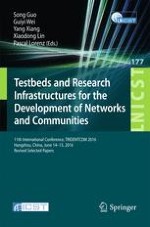2017 | Buch
Testbeds and Research Infrastructures for the Development of Networks and Communities
11th International Conference, TRIDENTCOM 2016, Hangzhou, China, June 14-15, 2016, Revised Selected Papers
herausgegeben von: Song Guo, Guiyi Wei, Yang Xiang, Xiaodong Lin, Pascal Lorenz
Verlag: Springer International Publishing
Buchreihe : Lecture Notes of the Institute for Computer Sciences, Social Informatics and Telecommunications Engineering
